Citroen DS3 2014 1.G Owner's Manual
Manufacturer: CITROEN, Model Year: 2014, Model line: DS3, Model: Citroen DS3 2014 1.GPages: 376, PDF Size: 12.55 MB
Page 201 of 376
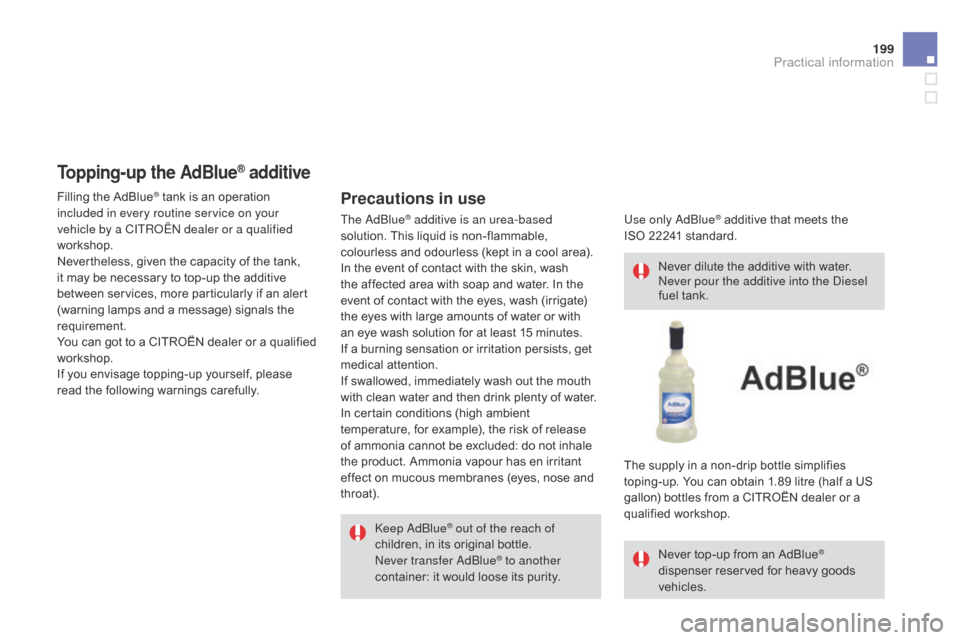
199
DS3_en_Chap10_info-pratiques_ed01-2014
keep a dblu e® out of the reach of
children,
in
its
original bottle.
Never transfer
a d
blu
e
® to another
container:
it
would
loose its purity. Never
dilute the additive with water.
Never pour the additive into the Diesel
fuel tank.
Never top-up from an AdBlue®
dispenser
reserved
for
heavy
goods
v
ehicles.
Filling
the
AdBlue
® tank is an operation i
ncluded in every routine service on your
vehicle by a CITR
oË
N dealer or a qualified
workshop.
Nevertheless,
given the capacity of the tank,
i
t
may
be
necessary to top-up the additive
b
etween
services,
more particularly if an alert
(
warning
lamps
and a message) signals the
r
equirement.
You
can
got
to
a
CITROËN dealer or a qualified
w
orkshop.
If
you
envisage
topping-up yourself, please
r
ead
the
following
warnings carefully.
Topping-up the AdBlue® additive
Precautions in use
Use only adblu e® additive that meets the I
SO 22241
standard.
The
supply
in
a
non-drip bottle simplifies
t
oping-up.
You
can obtain 1.89 litre (half a US
g
allon)
bottles
from a CITROËN dealer or a
q
ualified
w
orkshop.
The
a
dblu
e® additive is an urea-based
solution.
This liquid is non-flammable,
c
olourless
and odourless (kept in a cool area).
In
the
event
of contact with the skin, wash
t
he
affected
area with soap and water. In the
e
vent
of
contact with the eyes, wash (irrigate)
t
he
eyes
with large amounts of water or with
a
n
eye
wash
solution for at least 15 minutes.
I
f
a
burning
sensation or irritation persists, get
m
edical
attention.
If
swallowed, immediately wash out the mouth
w
ith
clean
water and then drink plenty of water.
In
certain
conditions (high ambient
t
emperature,
for example), the risk of release
o
f
ammonia
cannot be excluded: do not inhale
t
he
product.
Ammonia vapour has en irritant
e
ffect
on
mucous membranes (eyes, nose and
t
hroat).
Practical information
Page 202 of 376
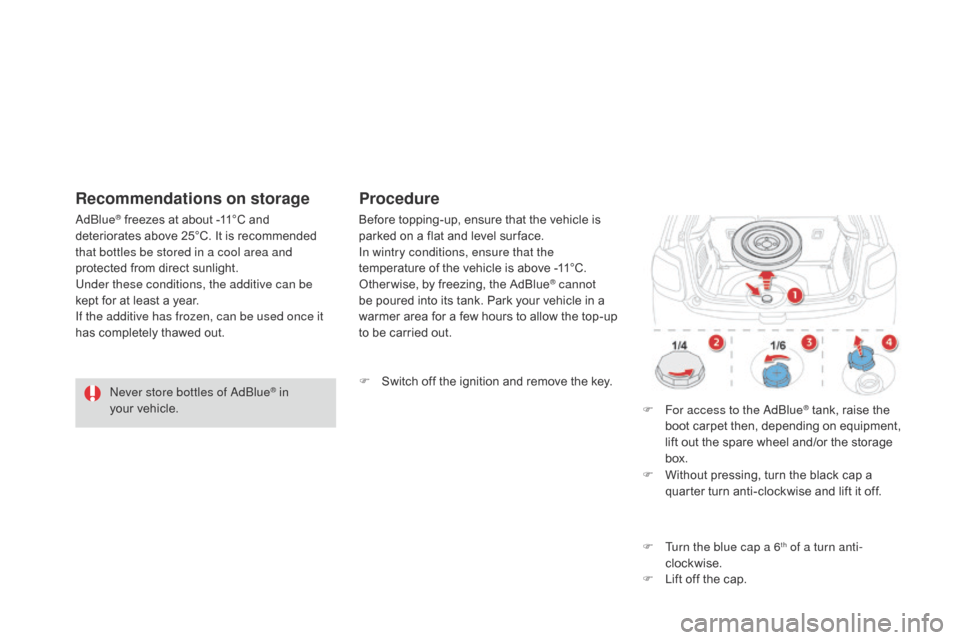
DS3_en_Chap10_info-pratiques_ed01-2014
Never store bottles of adblue® in
your vehicle.
a
d
blu
e
® freezes at about -11°C and d
eteriorates above 25°C. It is recommended
t
hat bottles be stored in a cool area and
protected
from direct sunlight.
Under these conditions, the additive can be
kept
for
at least a year.
If the additive has frozen, can be used once it
has
completely thawed out.
Recommendations on storage
Before topping-up, ensure that the vehicle is parked on a flat and level sur face.
In wintry conditions, ensure that the
temperature
of the vehicle is above -11°C.
O
ther wise, by freezing, the AdBlue
® cannot
be
poured
into
its
tank.
Park
your
vehicle in a
w
armer
area
for
a
few
hours
to
allow the top-up
t
o
be
carried
out.
Procedure
F Switch off the ignition and remove the key.
F
F
or access to the a
dbl
ue
® tank, raise the b
oot
carpet
then,
depending on equipment,
l
ift
out
the
spare
wheel
and/or the storage
b
ox.
F
W
ithout
pressing,
turn
the
black cap a
q
uarter
turn
anti-clockwise and lift it off.
F
T
urn the blue cap a 6
th of a turn anti-
clockwise.
F
L
ift
off
the
cap.
Page 203 of 376
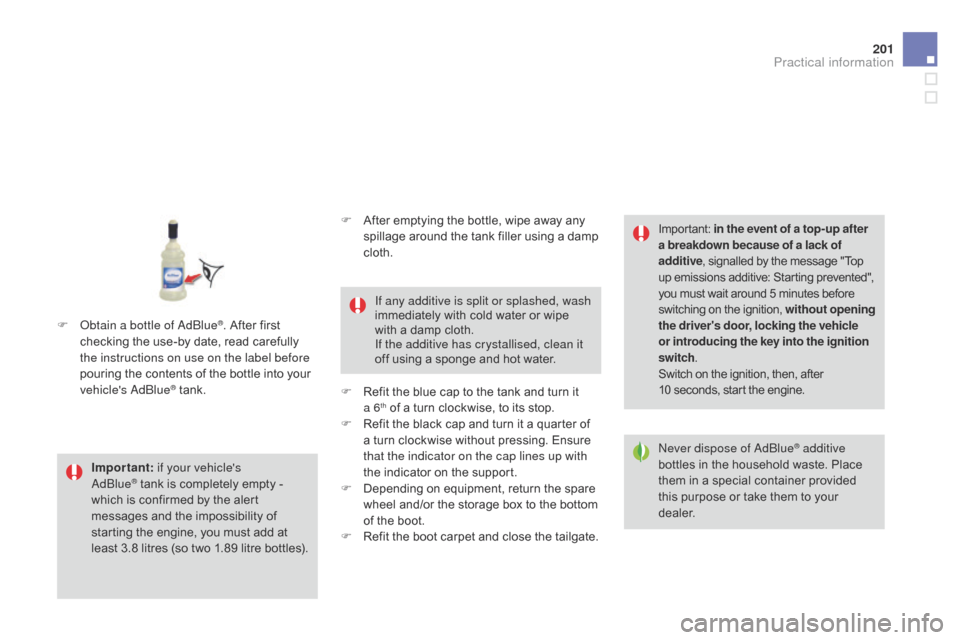
201
DS3_en_Chap10_info-pratiques_ed01-2014
Important: if your vehicle's a
dblu e® tank is completely empty - w
hich
is
confirmed by the alert
m
essages and the impossibility of
s
tarting
the engine, you must add at
l
east
3.8 litres (so two 1.89 litre bottles).If any additive is split or splashed, wash
immediately
with cold water or wipe
w
ith a damp cloth.
If the additive has crystallised, clean it
off using a sponge and hot water.Important:
i
n the event of a top-up after
a breakdown because of a lack of
additive , signalled by the message "Top
u
p emissions additive: Starting prevented",
y
ou must wait around 5 minutes before
s
witching
o
n
t
he
i
gnition,
w
ithout opening
the driver's door, locking the vehicle
or introducing the key into the ignition
switch .
Switch on the ignition, then, after
1
0 seconds, start the engine.
F
o
b
tain a bottle of a
dbl
ue
®. After first c
hecking
the
use-by
date,
read carefully
t
he instructions on use on the label before
pouring
the
contents
of
the bottle into your
v
ehicle's
a
d
blu
e
® tank. N ever dispose of a
dbl
ue
® additive
bottles
in
the
household
waste. Place
t
hem
in
a
special
container provided
t
his
purpose
or
take
them
to your
d
ealer.
F
A
fter
emptying
the
bottle,
wipe
away
any
s
pillage
around
the
tank
filler
using
a
damp
c
loth.
F
R
efit
the
blue
cap
to
the
tank
and
turn
it
a
6
th of a turn clockwise, to its stop.
F
R
efit the black cap and turn it a quarter of
a
turn clockwise without pressing. Ensure
t
hat the indicator on the cap lines up with
the
indicator on the support.
F
D
epending on equipment, return the spare
w
heel and/or the storage box to the bottom
o
f
the boot.
F
R
efit the boot carpet and close the tailgate.
Practical information
Page 204 of 376
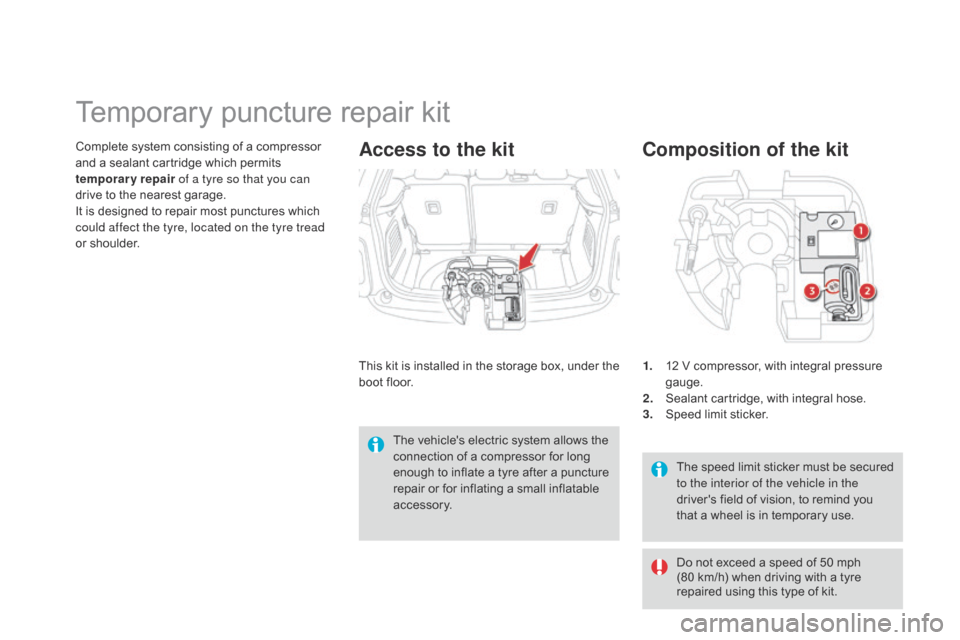
DS3_en_Chap10_info-pratiques_ed01-2014
The speed l imit s ticker m ust b e s ecured t
o the interior of the vehicle in the
driver's
field of vision, to remind you
t
hat a wheel is in temporary use.
composition of the kit
1. 12 V compressor, with integral pressure ga
uge.
2.
S
ealant cartridge, with integral hose.
3.
S
peed limit sticker.
Temporary puncture r epair k it
Complete system consisting of a compressor a
nd a sealant cartridge which permits
t
emporary repair of a tyre so that you can
drive
to the nearest garage.
It
is designed to repair most punctures which
c
ould affect the tyre, located on the tyre tread
or
shoulder.Access to the kit
This kit is installed i n t he s torage b ox, u nder t he b
oot floor.
The
vehicle's electric system allows the
c
onnection of a compressor for long
e
nough to inflate a tyre after a puncture
r
epair or for inflating a small inflatable
a
ccessory. Do
not exceed a speed of 50 mph
(
80 km/h) when driving with a tyre
r
epaired using this type of kit.
Page 205 of 376
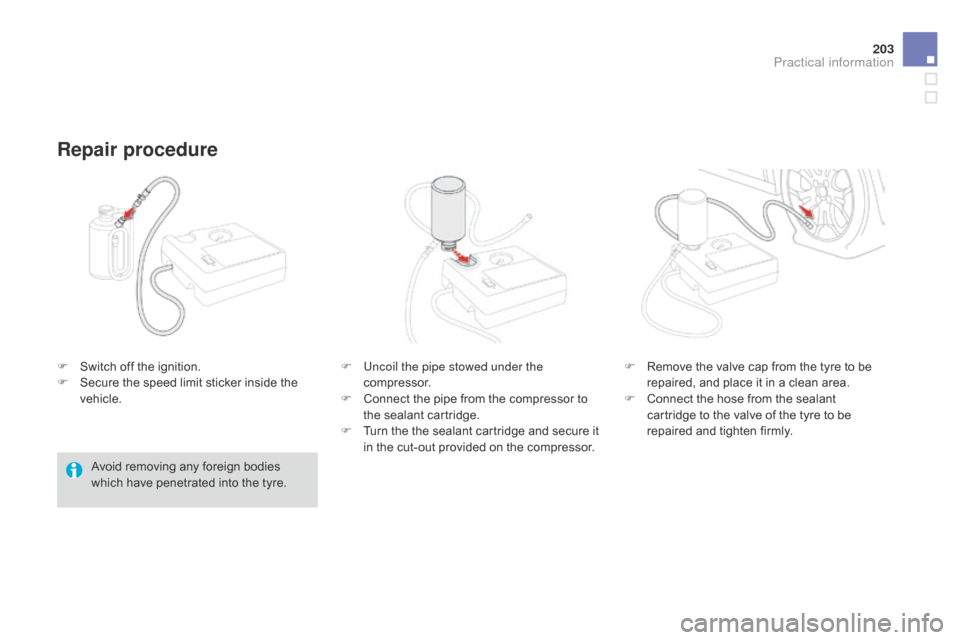
203
DS3_en_Chap10_info-pratiques_ed01-2014
F Switch off the ignition.
F S ecure the speed limit sticker inside the
v
ehicle.
Repair procedure
Avoid removing any foreign bodies which have penetrated into the tyre.F
U
ncoil the pipe stowed under the
compressor.
F
C
onnect the pipe from the compressor to
t
he sealant cartridge.
F
T
urn the the sealant cartridge and secure it
i
n the cut-out provided on the compressor.F
R
emove the valve cap from the tyre to be
r
epaired, and place it in a clean area.
F
C
onnect the hose from the sealant
c
artridge to the valve of the tyre to be
r
epaired and tighten firmly.
Practical information
Page 206 of 376
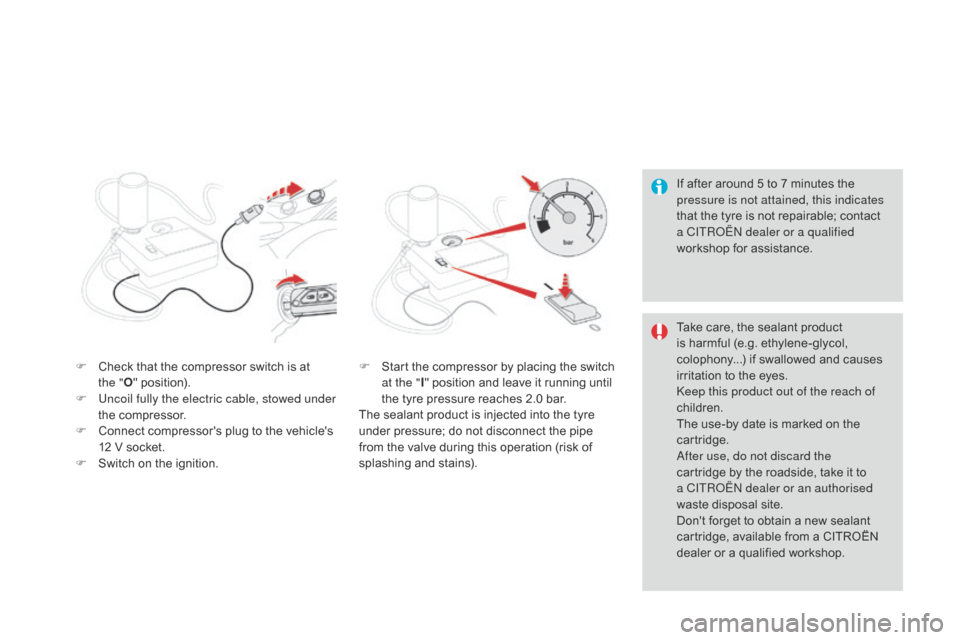
DS3_en_Chap10_info-pratiques_ed01-2014
If after around 5 to 7 minutes the pressure is not attained, this indicates
that
the tyre is not repairable; contact
a C
ITR
oË
N dealer or a qualified
workshop
for assistance.
F
C
heck
that
the
compressor
switch
is
at
t
he
" O "
position).
F
U
ncoil fully the electric cable, stowed under
the
compressor.
F
C
onnect
compressor's
plug
to
the
vehicle's
1
2
V
socket.
F
S
witch
on
the
ignition. F
S
tart
the
compressor
by
placing
the
switch
a
t the " I"
position
and
leave
it
running
until
t
he
tyre
pressure
reaches
2.0
bar.
The
sealant
product
is
injected
into
the
tyre
u
nder
pressure;
do
not
disconnect
the
pipe
f
rom
the
valve
during
this
operation
(risk
of
sp
lashing
an
d
s
tains). Take
care, the sealant product
i
s harmful (e.g. ethylene-glycol,
c
olophony...) if swallowed and causes
i
rritation to the eyes.
ke
ep this product out of the reach of
children.
The
use-by date is marked on the
c
artridge.
af
ter use, do not discard the
cartridge
by the roadside, take it to
a C
ITR
oË
N dealer or an authorised
waste
disposal site.
Don't
forget to obtain a new sealant
c
artridge, available from a CITROËN
d
ealer or a qualified workshop.
Page 207 of 376
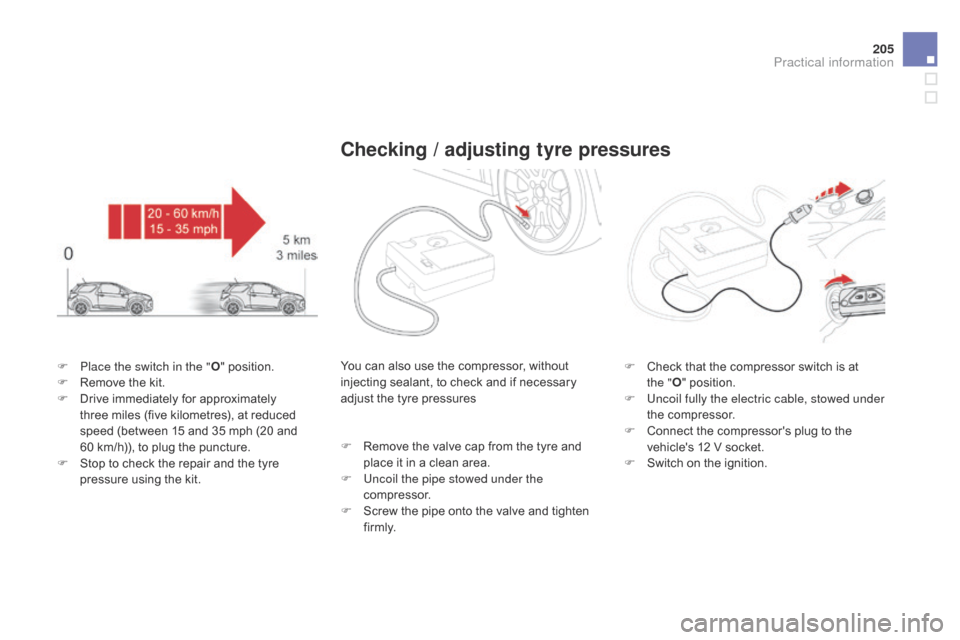
205
DS3_en_Chap10_info-pratiques_ed01-2014
F Place the switch in the "O" position.
F R emove the kit.
F
D
rive immediately for approximately
t
hree miles (five kilometres), at reduced
s
peed (between 15 and 35 mph (20 and
6
0 km/h)), to plug the puncture.
F
S
top to check the repair and the tyre
p
ressure using the kit.
checking / adjusting tyre pressures
You can also use the compressor, without injecting sealant, to check and if necessary
a
djust the tyre pressures
F
R
emove the valve cap from the tyre and
p
lace it in a clean area.
F
U
ncoil the pipe stowed under the
compressor.
F
S
crew the pipe onto the valve and tighten
f
i r m l y. F
C heck that the compressor switch is at
t
he "O "
position.
F
U
ncoil fully the electric cable, stowed under
the
compressor.
F
C
onnect the compressor's plug to the
v
ehicle's 12 V socket.
F
S
witch on the ignition.
Practical information
Page 208 of 376
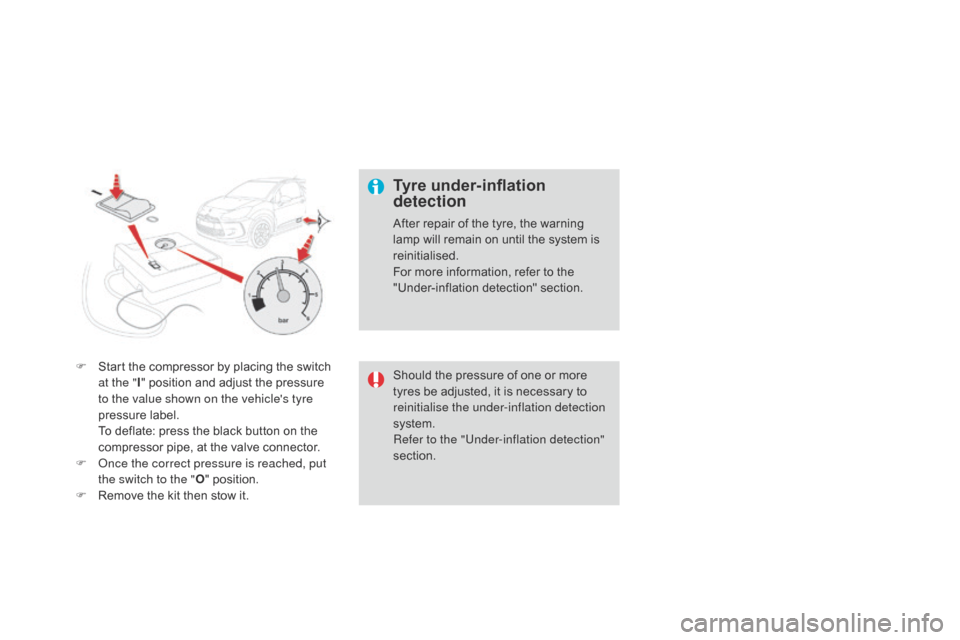
DS3_en_Chap10_info-pratiques_ed01-2014
F Start the compressor by placing the switch a
t the " I"
position and adjust the pressure
t
o the value shown on the vehicle's tyre
pressure
label.
T
o deflate: press the black button on the
c
ompressor pipe, at the valve connector.
F
o
n
ce the correct pressure is reached, put
the switch to the " O"
position.
F
R
emove the kit then stow it.
Tyre under-inflation
detection
After repair of the tyre, the warning lamp will remain on until the system is
r
einitialised.
For
more information, refer to the
"
Under-inflation
d
etection"
s
ection.
Should
the pressure of one or more
t
yres be adjusted, it is necessary to
r
einitialise the under-inflation detection
system.
Refer to the "Under-inflation detection"
section.
Page 209 of 376
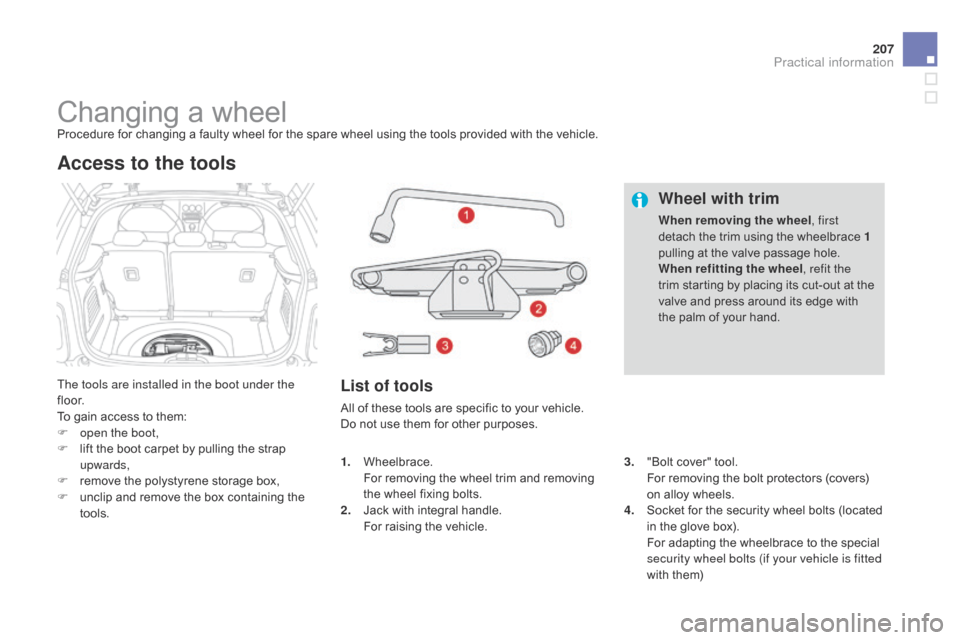
207
DS3_en_Chap10_info-pratiques_ed01-2014
Changing a wheelProcedure for changing a faulty wheel for the spare wheel using the tools provided with the vehicle.
T he tools are installed in the boot under the
f l o o r.
To
gain access to them:
F
o
pen the boot,
F
l
ift the boot carpet by pulling the strap
up
wards,
F
r
emove the polystyrene storage box,
F
u
nclip and remove the box containing the
to
ols.
Access to the tools
List of tools
All of these tools are specific to your vehicle. Do not use them for other purposes.
Wheel with trim
When removing the wheel , first
detach the trim using the wheelbrace 1
pulling
at the valve passage hole.
When refitting the wheel , refit the
trim
starting by placing its cut-out at the
v
alve and press around its edge with
t
he palm of your hand.
3.
"
Bolt cover" tool.
F
or removing the bolt protectors (covers)
o
n alloy wheels.
4.
S
ocket for the security wheel bolts (located
i
n
the glove box).
F
or adapting the wheelbrace to the special
s
ecurity wheel bolts (if your vehicle is fitted
with
them)
1.
W
heelbrace.
F
or
removing
the
wheel
trim
and
removing
t
he
wheel
fixing
bolts.
2.
J
ack
with
integral
handle.
F
or
raising
the
vehicle.
Practical information
Page 210 of 376
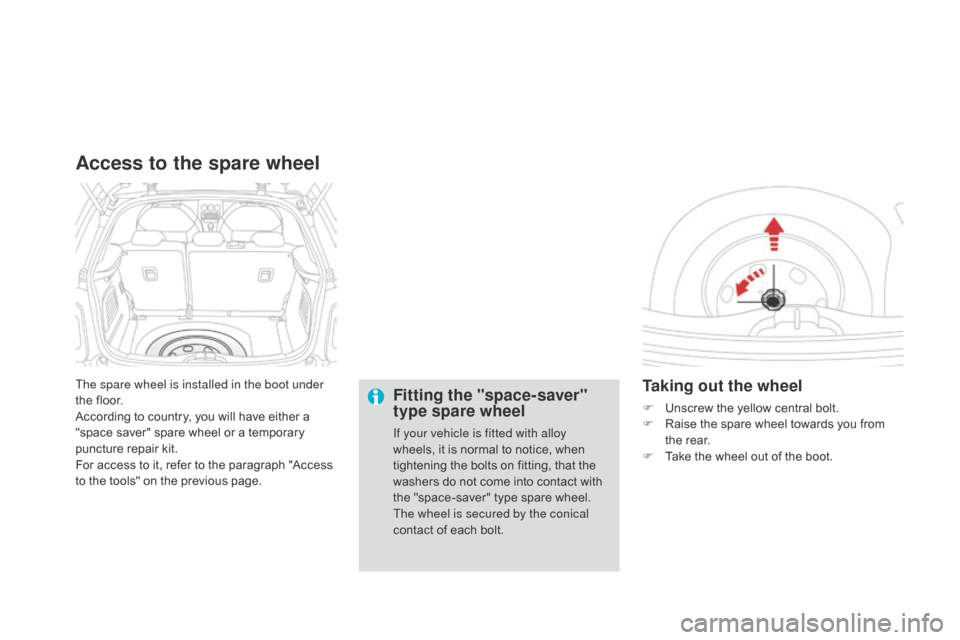
DS3_en_Chap10_info-pratiques_ed01-2014
The spare wheel is installed in the boot under
the floor.
According
to country, you will have either a
"
space saver" spare wheel or a temporary
p
uncture repair kit.
For
access to it, refer to the paragraph "Access
t
o the tools" on the previous page.
Access to the spare wheel
Fitting the "space-saver"
type spare wheel
If your vehicle is fitted with alloy
wheels, it is normal to notice, when
t
ightening the bolts on fitting, that the
w
ashers do not come into contact with
t
he "space-saver" type spare wheel.
T
he wheel is secured by the conical
contact
of each bolt.
Taking out the wheel
F Unscrew the yellow central bolt.
F R aise the spare wheel towards you from
t
he rear.
F
T
ake the wheel out of the boot.